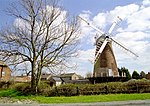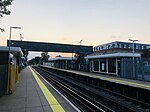Folkington Reservoir
Sites of Special Scientific Interest in East Sussex

Folkington Reservoir is a 5.8-hectare (14-acre) biological Site of Special Scientific Interest south-west of Polegate in East Sussex.The banks of the reservoir support a rich chalk grassland flora including kidney vetch, horseshoe vetch, pyramidal orchid, fragrant orchid and the rare and protected hairy mallow. The reservoir itself is covered and the bare chalk on top supports ruderal species such as scarlet pimpernel and parsley piert.
Excerpt from the Wikipedia article Folkington Reservoir (License: CC BY-SA 3.0, Authors, Images).Folkington Reservoir
Folkington Road, Wealden Long Man
Geographical coordinates (GPS) Address Nearby Places Show on map
Geographical coordinates (GPS)
| Latitude | Longitude |
|---|---|
| N 50.81 ° | E 0.219 ° |
Address
Folkington
Folkington Road
BN26 5SA Wealden, Long Man
England, United Kingdom
Open on Google Maps








